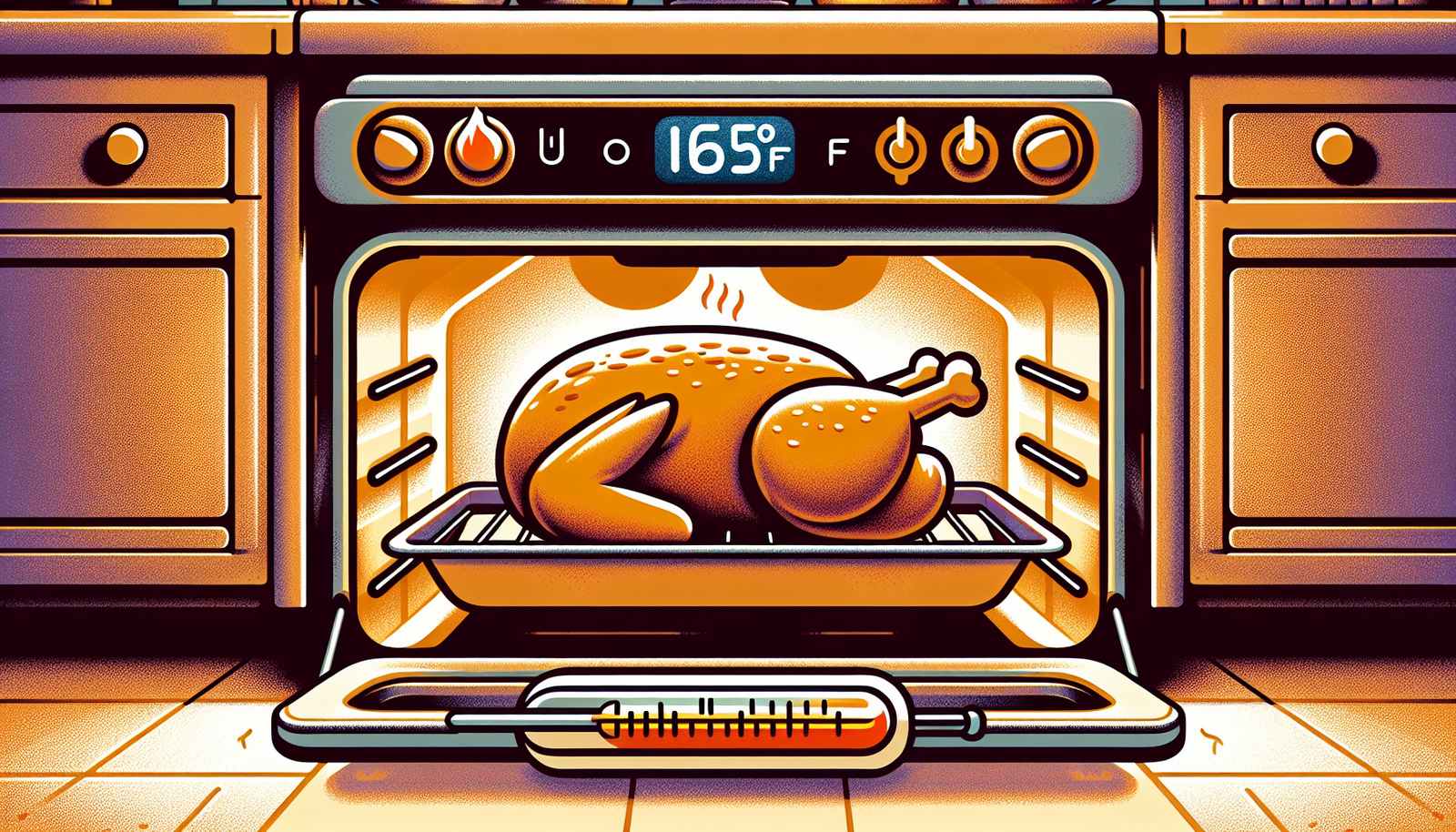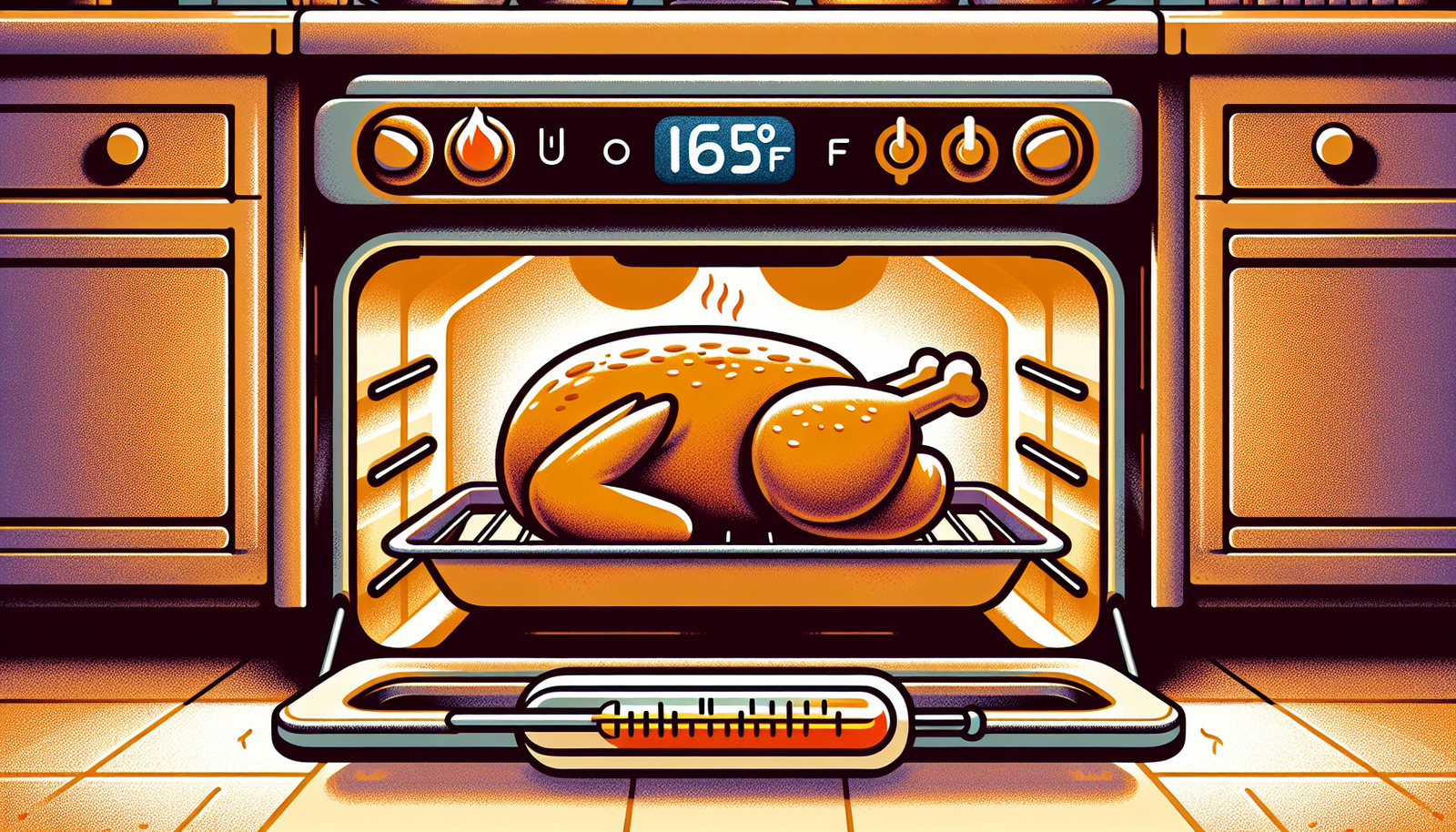Have you ever wondered if it’s safe to eat chicken cooked to 165 degrees? Well, you’re not alone. Many people are concerned about the appropriate temperature for cooking chicken to ensure it is both delicious and safe to consume. In this article, we will address this common question and provide you with all the information you need to confidently enjoy your chicken without any worries. So, let’s dig into the world of chicken cooking temperatures and find out if 165 degrees is the sweet spot we’ve been searching for!

Understanding Safe Cooking Temperatures
The Importance of Cooking Chicken Properly
Cooking chicken to the proper temperature is crucial to ensure food safety and prevent potential risks of foodborne illnesses. Raw chicken can harbor harmful bacteria such as Salmonella, Campylobacter, and Listeria, which can cause serious health problems when ingested. By cooking chicken to the right temperature, you can effectively destroy these bacteria and safeguard your health.
Different Temperature Recommendations
Different organizations and culinary experts may have varying guidelines for safe cooking temperatures of chicken. However, the United States Department of Agriculture (USDA) recommends an internal temperature of 165 degrees Fahrenheit (74 degrees Celsius) as the minimum safe temperature for chicken. This temperature ensures that any potential bacteria are completely killed, reducing the risk of food poisoning.
Understanding the Danger Zone
The danger zone refers to the temperature range between 40 degrees Fahrenheit (4 degrees Celsius) and 140 degrees Fahrenheit (60 degrees Celsius). This temperature range is favorable for bacterial growth and can lead to the proliferation of harmful pathogens on food, including chicken. To avoid the danger zone, it is important to cook chicken to a safe internal temperature, such as 165 degrees Fahrenheit, and keep it out of the danger zone when storing leftovers.
Is 165 Degrees Safe for Chicken?
Recommended Temperature by USDA
As mentioned earlier, the USDA recommends cooking chicken to an internal temperature of 165 degrees Fahrenheit (74 degrees Celsius). This temperature kills any potential bacteria present in the chicken, ensuring it is safe for consumption. It is important to note that this temperature applies to all parts of the chicken, including the breasts, thighs, wings, and drumsticks.
Ensuring Safe Consumption
While 165 degrees Fahrenheit is considered safe for consumption, it is essential to remember that this is the minimum recommended temperature. Some individuals may prefer higher cooking temperatures to ensure thorough cooking. Additionally, factors such as the method of cooking and the size of the chicken pieces can affect the cooking time. It is always best to use a meat thermometer to accurately determine the doneness of the chicken.
Factors Affecting Cooking Temperature
Several factors can affect the cooking temperature required for chicken. The thickness of the chicken, the initial temperature of the meat, and even the equipment used for cooking can impact the cooking time and temperature necessary to achieve the desired level of doneness. Adjustments may need to be made based on these factors to ensure the chicken is both safe to eat and enjoyable.
Determining the Doneness of Chicken
Using a Meat Thermometer
To accurately determine the doneness of chicken, a meat thermometer is an invaluable tool. Insert the probe of the thermometer into the thickest part of the chicken, making sure it does not touch bone or the cooking vessel. By checking the internal temperature, you can easily assess if the chicken has reached the recommended 165 degrees Fahrenheit or if it requires further cooking.
Visual Cues
While a meat thermometer provides the most precise results, visual cues can also help determine the doneness of chicken. The chicken should have a golden brown color and the juices should run clear when pierced with a fork. However, solely relying on visual cues may not be sufficient to guarantee that the chicken is cooked to a safe temperature, so a meat thermometer is still the best practice.
Avoiding Undercooked Chicken
Undercooked chicken carries potential health risks because it may still harbor harmful bacteria. Consuming undercooked chicken can lead to foodborne illnesses. To avoid undercooked chicken, always ensure it reaches the proper internal temperature of 165 degrees Fahrenheit. Taking shortcuts or guessing the doneness of chicken can have serious consequences, so it is better to be safe than sorry.
Effects of Overcooking Chicken
Dry and Tough Texture
Overcooking chicken can result in a dry and tough texture. It can cause the meat to lose its juiciness, making it less enjoyable to eat. The proteins in the chicken become denatured, leading to a chewy and rubbery texture. To avoid this, it is important to monitor the cooking time and temperature accurately to achieve the desired level of doneness without overcooking.
Decreased Flavor
Overcooking chicken can also impact its flavor. The prolonged exposure to high heat can cause the natural juices and flavors to evaporate, resulting in bland and tasteless chicken. To preserve the flavor, it is essential to cook chicken to its recommended safe internal temperature while avoiding overcooking.
Food Safety Considerations
While overcooked chicken may not pose immediate health risks like undercooked chicken, it is still important to prioritize food safety. Cooking chicken to the proper temperature ensures that any potential bacteria or pathogens are eliminated, reducing the risk of foodborne illnesses. Balancing both safety and taste is crucial to enjoy a flavorful and safe chicken dish.
Alternative Cooking Methods
Sous Vide Cooking
Sous vide cooking is a popular cooking method that involves vacuum-sealing chicken and cooking it in a precisely controlled water bath. This method allows the chicken to be cooked at lower temperatures for a longer duration, resulting in tender and moist meat. However, it is important to note that cooking chicken sous vide still requires reaching the recommended internal temperature of 165 degrees Fahrenheit to ensure food safety.
Brining Chicken
Brining is a technique that involves soaking chicken in a mixture of water, salt, and sometimes sugar or other flavorings. This process helps the chicken retain moisture, resulting in juicier and more flavorful meat when cooked. While brining does not impact the recommended cooking temperature for chicken, it can enhance the overall taste and texture.
Marinating Chicken
Marinating chicken is another method used to enhance flavor and tenderness. By soaking chicken in a seasoned liquid mixture, such as a combination of herbs, spices, oil, and acidic ingredients like lemon juice or vinegar, the chicken absorbs the flavors and becomes more tender. However, it is important to remember that marinades do not affect the recommended cooking temperature for chicken.
Handling Leftover Chicken
Storing Cooked Chicken Properly
After cooking chicken, it is important to handle and store the leftovers properly to maintain their quality and safety. Once the chicken has cooled down, store it in airtight containers or wrap it tightly in foil or plastic wrap. Place the containers or wrapped chicken in the refrigerator, where it should be kept at or below 40 degrees Fahrenheit to prevent bacterial growth. Leftover chicken should be consumed within 3-4 days.
Reheating Chicken Safely
When reheating cooked chicken, it is crucial to ensure it reaches a safe internal temperature of 165 degrees Fahrenheit to kill any bacteria that may have grown during storage. This can be achieved by using a microwave or an oven. Avoid reheating chicken multiple times, as it increases the risk of bacterial growth. It is best to reheat only the amount of chicken that will be immediately consumed.
Food Safety Tips
Avoiding Cross-Contamination
Cross-contamination occurs when bacteria from one food item are transferred to another, leading to potential foodborne illnesses. To avoid cross-contamination when handling raw chicken, it is important to thoroughly clean all utensils, cutting boards, and surfaces that come into contact with raw chicken. Use separate plates and utensils for raw and cooked chicken to prevent any bacterial contamination.
Proper Hand Hygiene
Proper hand hygiene is crucial when handling chicken or any raw meat. Always wash your hands with warm soapy water before and after handling chicken. This helps to eliminate any potential bacteria that could spread to other surfaces or food items. Avoid touching other food items, such as vegetables or ready-to-eat foods, after handling raw chicken without properly washing your hands.
Storage and Refrigeration Guidelines
To ensure food safety, it is essential to store raw chicken in the refrigerator or freezer promptly after purchase. Keep raw chicken in sealed containers or sealed plastic bags to prevent any potential bacterial contamination. In the refrigerator, store raw chicken on the bottom shelf to prevent any drippings from contaminating other foods. Follow the expiration dates on the packaging and discard any chicken that has gone bad or has an unusual smell.
Common Myths about Chicken Cooking Temperatures
Color as a Reliable Indicator
Contrary to popular belief, the color of cooked chicken is not always a reliable indicator of its doneness or safety. Cooked chicken can retain a pink hue even when it has reached the recommended internal temperature of 165 degrees Fahrenheit. To ensure safety, always use a meat thermometer to confirm the chicken’s internal temperature, regardless of its color.
Killing Bacteria through Cooking
Cooking chicken to the recommended internal temperature of 165 degrees Fahrenheit effectively kills most harmful bacteria. However, it is important to note that not all bacteria produce visible signs of spoilage or change in color. Even when cooked at the proper temperature, there may still be some bacteria present. Thorough cooking is necessary to minimize the risk of foodborne illnesses.
The Dangers of Pink Meat
Contrary to popular belief, pink meat does not always indicate undercooked or unsafe chicken. Some factors, such as the age or breed of the chicken, can cause pink-colored meat even when fully cooked. As long as the chicken reaches the recommended internal temperature of 165 degrees Fahrenheit, it is safe to consume, regardless of its color.
Foodborne Illnesses Associated with Chicken
Salmonella
Salmonella is one of the most common foodborne pathogens associated with chicken. It can cause symptoms such as diarrhea, abdominal cramps, fever, and vomiting. By cooking chicken to its recommended safe internal temperature, you can effectively kill any potential Salmonella bacteria, reducing the risk of infection.
Campylobacter
Campylobacter is another common bacteria found in chicken that can cause foodborne illnesses. Consuming undercooked chicken contaminated with Campylobacter can lead to symptoms such as diarrhea, fever, and abdominal pain. Proper cooking and safe food handling practices are essential to prevent Campylobacter infections.
Listeria
Listeria is a bacteria that can contaminate chicken and cause a serious infection called listeriosis. Pregnant women, the elderly, and individuals with weakened immune systems are particularly susceptible to listeriosis. Cooking chicken to the recommended internal temperature, practicing good hygiene, and avoiding cross-contamination can minimize the risk of Listeria contamination.
Safety Guidelines for Special Populations
Pregnant Women
Pregnant women are more susceptible to certain foodborne illnesses, including those associated with chicken. To protect both themselves and their unborn child, pregnant women should take extra precautions when handling and consuming chicken. It is advisable to cook chicken to its recommended internal temperature, avoid consuming raw or undercooked chicken, and practice proper food safety and hygiene.
Children
Children, especially those with developing immune systems, are more vulnerable to foodborne illnesses. Parents and caregivers should ensure that chicken is cooked to a safe internal temperature and served hot. Avoid giving young children undercooked or raw chicken, and encourage good hand hygiene when handling and consuming chicken.
Elderly Individuals
Elderly individuals, particularly those with weakened immune systems, are at a higher risk of foodborne illnesses. It is crucial to handle and cook chicken safely to reduce the risk of contamination. Elderly individuals should avoid consuming raw or uncooked chicken and ensure that any chicken they consume is cooked to the recommended internal temperature of 165 degrees Fahrenheit. Good hygiene practices are also essential in preventing foodborne illnesses in this population.

